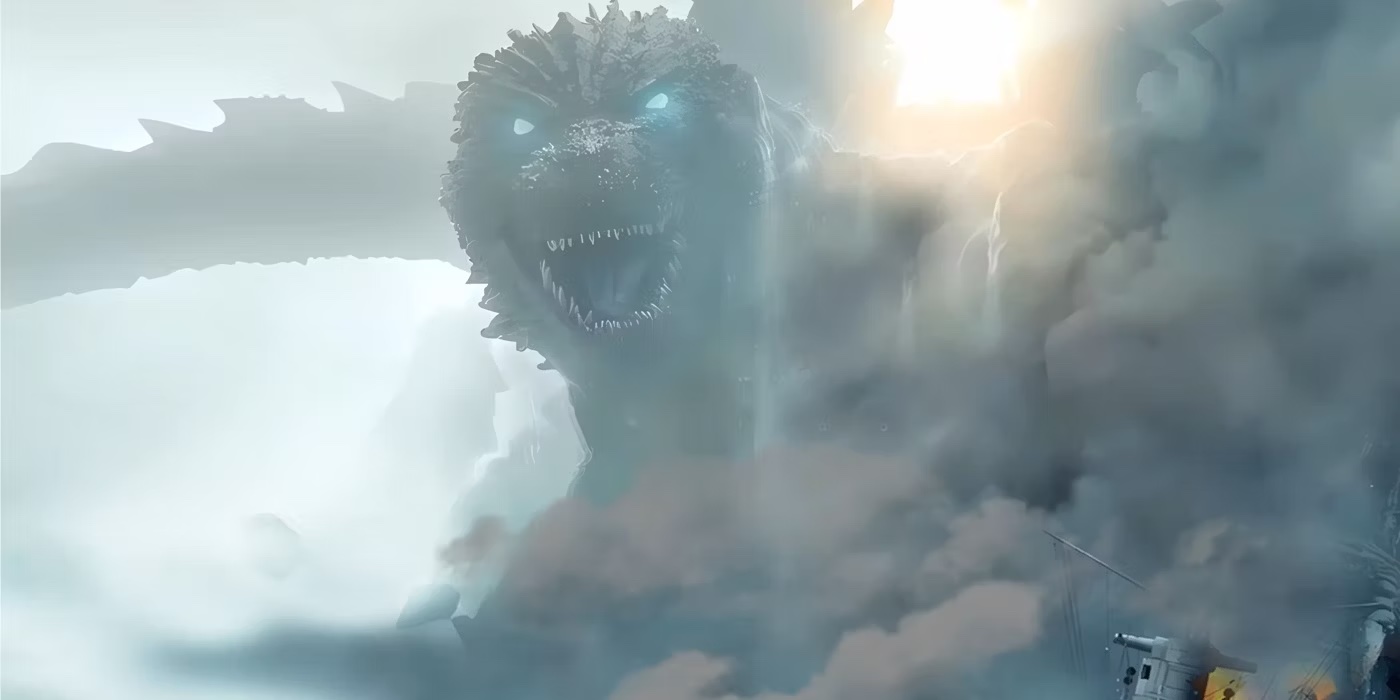
Godzilla is scary in Godzilla Minus One, like, heart-racing, muscle-tensing scary. Godzilla has never been scary. He has been devastating (1954), triumphant (1964-1975), eerie (2016), and awe-inspiring (1984 Toho – present day Legendary series), but not scary, not until now.
Godzilla is such a wonderful cinematic creation. No movie monster brings me more delight. I’ve written before about how he hearkens back to Job’s leviathan and other giant animals of myth and legend in human history. 65 million years separated humans and dinosaurs. We never interacted, but when I watch Godzilla stride through a cityscape, I wonder if we don’t have residual memories of giant lizards baked into our DNA somehow. Godzilla himself is a nuclear-age terror, but the terror of an inhuman colossus dispassionately destroying and consuming our world is a fundamental fear.
This Godzilla appears to be amazed at the destruction he can cause. I wonder if people who set off atomic bombs feel the thrill of awesome power. Probably. When I build block towers on my living room floor my toddlers rejoice to knock them over. We theology and art types like to champion humanity’s creative impulse, but we’d be dishonest to not note our destructive nature as well. And it isn’t just sin. There’s a fair amount of apocalypse in the Bible, and God is the one razing the earth in those stories. We’re made in God’s image, right? That must mean we’re inclined to wipe the world clean too.
Godzilla Minus One resurrects Godzilla’s fear factor by borrowing from some of cinema’s greatest artists. There’s a lot of Jaws and Miyazaki in Minus One. And we’re not only talking atmosphere here. The movie puts relatable characters at the center of the mayhem, giving us an emotional anchor point to attach to as the movie pulls us through its terrifying scenes. You tremble but you also might cry. Stories are scarier when we can imagine ourselves in the middle of them.
When we can identify with the characters, we also get to feel cathartic release when they survive. Blockbusters have pushed ordinary humans to the periphery of the drama in recent decades. I enjoy watching super humans battle baddies, but no part of me imagines that I would also be able to win those fights. In addition to featuring a monster who seems to be amazed at the destruction he can cause, Godzilla Minus One also features courageous and ingenious people intent on stopping Godzilla’s destructive raid. That’s inspiring, especially in a time when the issues we face feel insurmountable.
I like being reminded of our capacity for destruction and our capacity to love. So I don’t mind if Godzilla keeps rampaging through our cinemas if the movies are as good as Godzilla Minus One.
Godzilla is scary in Godzilla Minus One, like, heart-racing, muscle-tensing scary. Godzilla has never been scary. He has been devastating (1954), triumphant (1964-1975), eerie (2016), and awe-inspiring (1984 Toho – present day Legendary series), but not scary, not until now.
Godzilla is such a wonderful cinematic creation. No movie monster brings me more delight. I’ve written before about how he hearkens back to Job’s leviathan and other giant animals of myth and legend in human history. 65 million years separated humans and dinosaurs. We never interacted, but when I watch Godzilla stride through a cityscape, I wonder if we don’t have residual memories of giant lizards baked into our DNA somehow. Godzilla himself is a nuclear-age terror, but the terror of an inhuman colossus dispassionately destroying and consuming our world is a fundamental fear.
This Godzilla appears to be amazed at the destruction he can cause. I wonder if people who set off atomic bombs feel the thrill of awesome power. Probably. When I build block towers on my living room floor my toddlers rejoice to knock them over. We theology and art types like to champion humanity’s creative impulse, but we’d be dishonest to not note our destructive nature as well. And it isn’t just sin. There’s a fair amount of apocalypse in the Bible, and God is the one razing the earth in those stories. We’re made in God’s image, right? That must mean we’re inclined to wipe the world clean too.
Godzilla Minus One resurrects Godzilla’s fear factor by borrowing from some of cinema’s greatest artists. There’s a lot of Jaws and Miyazaki in Minus One. And we’re not only talking atmosphere here. The movie puts relatable characters at the center of the mayhem, giving us an emotional anchor point to attach to as the movie pulls us through its terrifying scenes. You tremble but you also might cry. Stories are scarier when we can imagine ourselves in the middle of them.
When we can identify with the characters, we also get to feel cathartic release when they survive. Blockbusters have pushed ordinary humans to the periphery of the drama in recent decades. I enjoy watching super humans battle baddies, but no part of me imagines that I would also be able to win those fights. In addition to featuring a monster who seems to be amazed at the destruction he can cause, Godzilla Minus One also features courageous and ingenious people intent on stopping Godzilla’s destructive raid. That’s inspiring, especially in a time when the issues we face feel insurmountable.
I like being reminded of our capacity for destruction and our capacity to love. So I don’t mind if Godzilla keeps rampaging through our cinemas if the movies are as good as Godzilla Minus One.

Elijah Davidson is Co-Director of Brehm Film and Senior Film Critic. Subscribe to Come & See, his weekly newsletter that guides you through the greatest films ever made, and find more of his work at elijahdavidson.com.
There are over a thousand film festivals in the U.S. alone each year, but Sundance is the one we keep returning to. Why?